SEO
9 SaaS Marketing Strategies for Sustainable Growth

Sustainable growth for a SaaS company is about creating long-term value that is a) profitable and b) able to be maintained over time without compromising the brand’s reputation. In other words, by building growth, you’re building a foundation for more growth as you go.
We’ll talk about nine marketing strategies that are perfect for achieving and maintaining sustainable growth.
Product-market fit (PMF) is when a business has confirmed signals that its product can satisfy an existing demand in a market with high potential.
The usual sign of achieving PMF is when people are willing to buy the product (even if it’s not perfect yet), actively use it, and recommend it to others.
This is a sustainable strategy because it allows you to make sure you’re building something meaningful that will actually get paying users.
PMF automatically makes your messaging more effective. You’re promoting a product people want. And you already know who you’re talking to, so your marketing dollars are better spent.
Conversely, if none of your marketing efforts seem to work, the problem may be the product and not how creative or well funded your campaigns are.
You can find SaaS companies with product-market fit all around. These will be companies that still offer the same kind of products that made them profitable: Slack, Atlassian, Shopify, etc.
How it works
The general idea is to ship a Minimum Viable Product (MVP) and iterate on it based on real user input until you see that people actively use it and recommend it.
There are five steps in the process:
- Formulate the value hypothesis: Why is a customer likely to buy your product?
- Specify the features of your MVP: The right quantity and quality of features needed to verify the value hypothesis.
- Build your MVP: There are many ways to present your product to your audience; you don’t necessarily need to develop a fully functional product.
- Test the MVP with real users: In other words, get feedback.
- Learn from your users and iterate: Some ideas will need more work, while some are probably destined to fail. Gather your data and make the decision.
When you achieve PMF, it will be time to scale your company and marketing efforts.
This strategy doesn’t need an introduction. We’ve all used product trials and free tools. That said, this strategy can be looked at from different angles. What’s important from a marketing perspective are these three benefits:
- Reduced friction – This means there are fewer objections to trying your product.
- Time to experience the value of the product and get hooked – Reading about a product on a landing page is not the same as experiencing it. Your potential customers will likely expect the possibility to put their hands on the product before they buy.
- Direct marketing channel – You can ask users to sign up for a newsletter or send them messages concerning the product.
For instance, HubSpot carves out parts of the platform for free usage (e.g., CRM, CMS). It does this, as it explains, to increase the force of its marketing flywheel. Or in other words, to propel its entire business model.
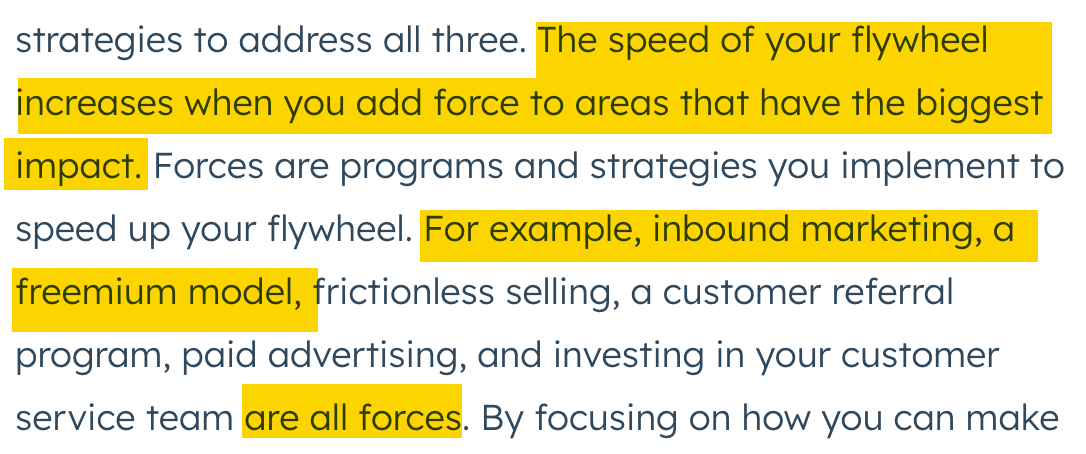
How it works
Start by weighing the pros and cons of free and freemium products.
| Pros | Cons |
|---|---|
| Less friction with getting people to use your product. | Harder to manage expectations. People may expect to get more things for free. |
| Bigger user base. | More server load and possibly more queries to support. |
| Works well with growth loops (more on that later). | Offering something for free may reduce its perceived value. |
| Direct marketing channel to signed-up users (content distribution and upselling). | |
| More feedback. |
Getting users in front of free products is only part of the job. The harder part is getting them to upgrade.
First off, you need to set the right expectations—you won’t convert all of them. For the ones that are “convertible,” here are some tactics you can use:
- Never stop improving customer satisfaction. What your product does and how it does it is absolutely fundamental.
- Educate users about the product. Use blog posts, videos, or quick in-app tips.
- Offer limited access to all newly developed features. For instance, you can allow everyone to use each new feature for five days for free.
- Provide excellent customer service.
- Offer flexible payment options.
When looking for ideas for free products that will generate traffic, try a keyword research tool like Ahrefs’ Keywords Explorer. You can:
- Enter features of your product.
- Go to the Matching terms report.
- Use the Include filter with keyword modifiers pointing to tools, for example: “tool, check, checker, finder, analyzer, builder, free.” Set to “Any word.”
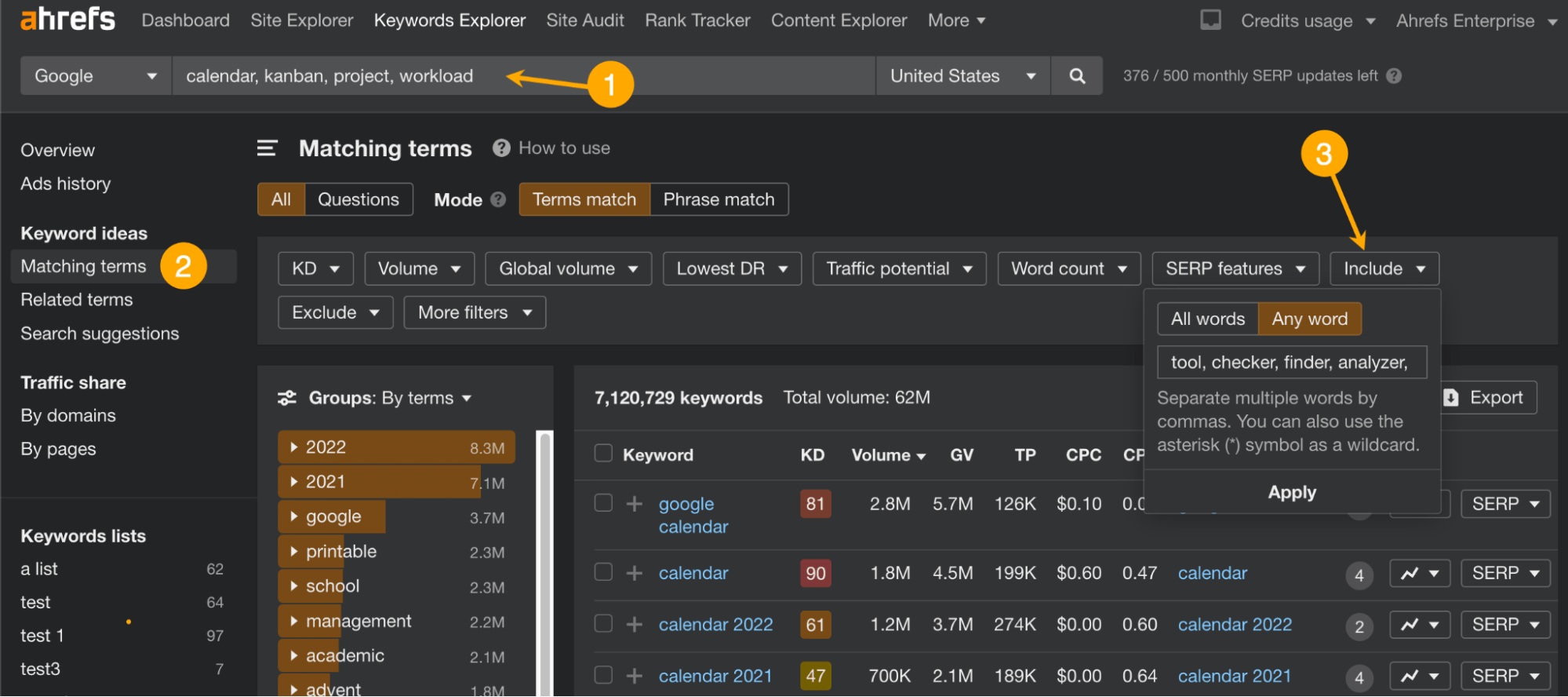
To illustrate, our free website traffic checker tool generates an estimated 33.4K organic visits each month from ranking for keywords like “website traffic checker” or even “website traffic.”


Content marketing is the process of creating and distributing content to attract and retain customers.
If you add search engine optimization to the equation, you get a framework for creating content relevant to your business and the reader. You also get a built-in distribution engine that generates almost free traffic.
SEO is one of the most sustainable marketing strategies because it generates passive traffic that accumulates over time and can generate traffic even years after. To put it differently, SEO results are continuous—and you don’t get that with all marketing strategies.
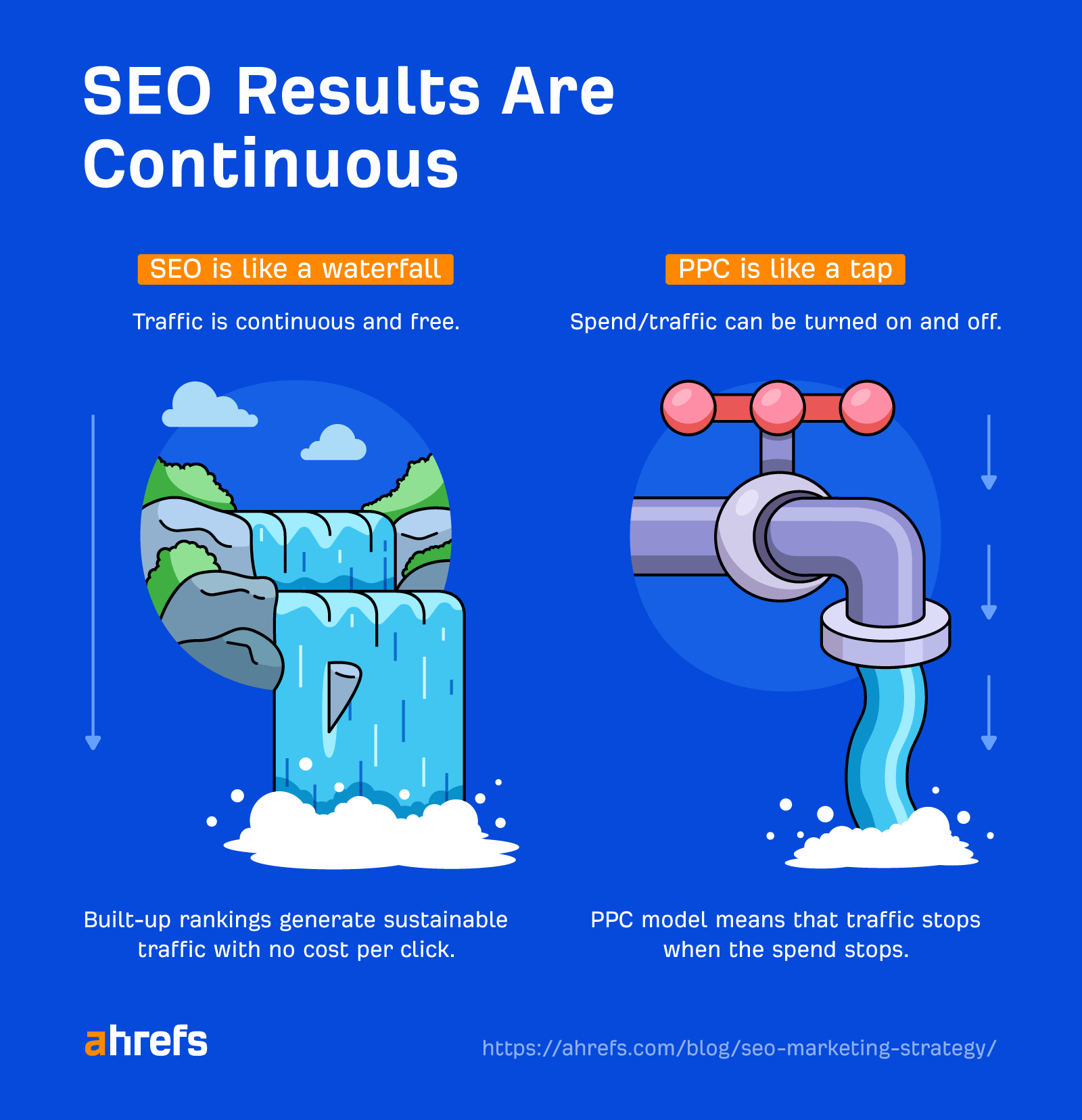
Our blog is an example of such a strategy. It brings an estimated 628K organic visits each month, worth around $860K in ad money, through regular publishing of SEO content.

How it works
SEO is generally worth it if at least one of these is true:
- People are searching for what you sell or do.
- People are searching for solutions to problems your business helps to solve.
- You can give a better solution than the conventional one people are searching for.
In any case, the core of this strategy is to find relevant keywords with traffic potential. The right keywords can connect you with your target audience and create an opportunity to pitch your product. And if you’re not ranking for these keywords, your competitors will.
The process of finding the right keywords for your website is called keyword research. Here’s a quick rundown:
- Go to Keywords Explorer
- Enter industry-related seed keywords, e.g., “seo, digital marketing, keyword, backlink”
- See keyword ideas in the Matching terms report
- Use the filters to refine results if needed (e.g., look only for low-competition keywords or keywords with a certain minimum traffic potential)

Other elements of the SEO process are building a sound technical foundation, creating optimized content, and building links. You can learn how to start with the entire process in our beginner’s guide to SEO.
A user community can help your SaaS product in a number of ways:
- It helps to make the product better through feedback.
- It helps to spread word of mouth about the product even if the community is exclusive.
- It offers added value to the user—they can learn from others in the community and network.
Building a user community is a sustainable strategy because it leverages existing customers and can help facilitate long-term engagement with the product.
A famous example of a community with a price tag on it is Behance, acquired by Adobe for $150M. It generates over 10M search visits each month and allows the parent company to bring the design community very close to its product.
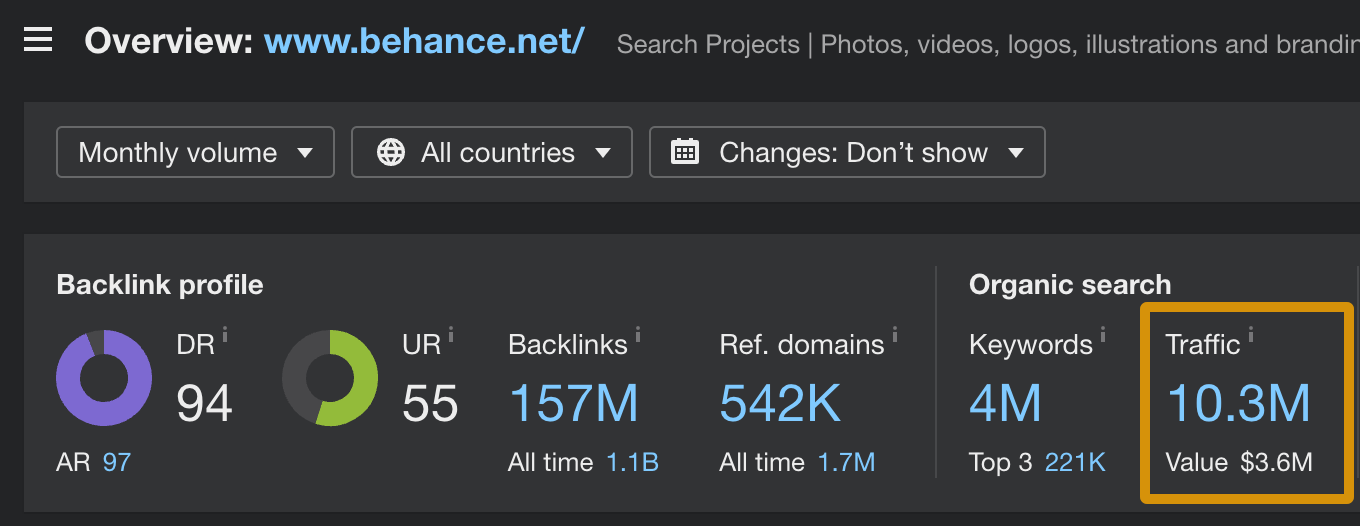

How it works
In a nutshell: create a place where people can meet online, build a constant presence there, and animate the community (feature launches, discussions, polls, etc.).
For example, at Ahrefs, we offer access to our exclusive community, Ahrefs Insider, with every subscription. All we needed to start it was a regular community feature on Facebook. Now it gathers a total of 17K registered users.

Earned media is publicity gained organically from promotional efforts, like press coverage, social media mentions, and search engine rankings.
Earned media is a sustainable form of marketing for these reasons:
- It’s cheaper in the long run compared to advertising (sometimes even free).
- It’s long lasting.
- It earns your brand awareness and credibility.
Here’s an example that checks all three boxes. A while ago, we published a data study showing that 90.63% of content gets no traffic from Google. This article was mentioned by multiple reputable websites, including NY Times, Forbes, and main SEO blogs. All of that coverage gave us free brand exposure and backlinks.

How it works
Earned traffic covers a wide range of marketing tactics, so there’s no silver bullet here. Besides SEO content, which we already touched on, the tactics that are repeatable and will probably have the most impact over time are:
When vetting which site to pitch your product, story, or quote to, you can use Ahrefs’ SEO Toolbar. For instance, say you’re looking for websites that review SaaS products like yours. Just search for your competitors’ reviews in Google and look at the metrics to see which sites can send you stronger links and considerable traffic.

Multi-channel marketing is basically about interacting with your audience using different marketing channels: social media, search, podcasts, email, etc.
Using multi-channel marketing will have the following advantages:
- A broader reach.
- Channels can work to support each other. For example, social media can help you to get links to websites and boost your SEO.
- You create convenience for your audience to interact with the brand.
- There’s less risk, thanks to diversification.
The idea behind this strategy is that your audience is likely scattered across various websites and social media platforms. So even if one marketing channel works exceptionally well, you probably shouldn’t drop all other channels.
How it works
Here are some ideas on how to find the best marketing channels for your business:
- You can see where your competitors promote.
- Do keyword research to estimate organic traffic for relevant keywords (we discussed it in point #3).
- Use audience research tools like SparkToro. Below, you can see a screenshot showing what kind of data about your audience the tool can provide.
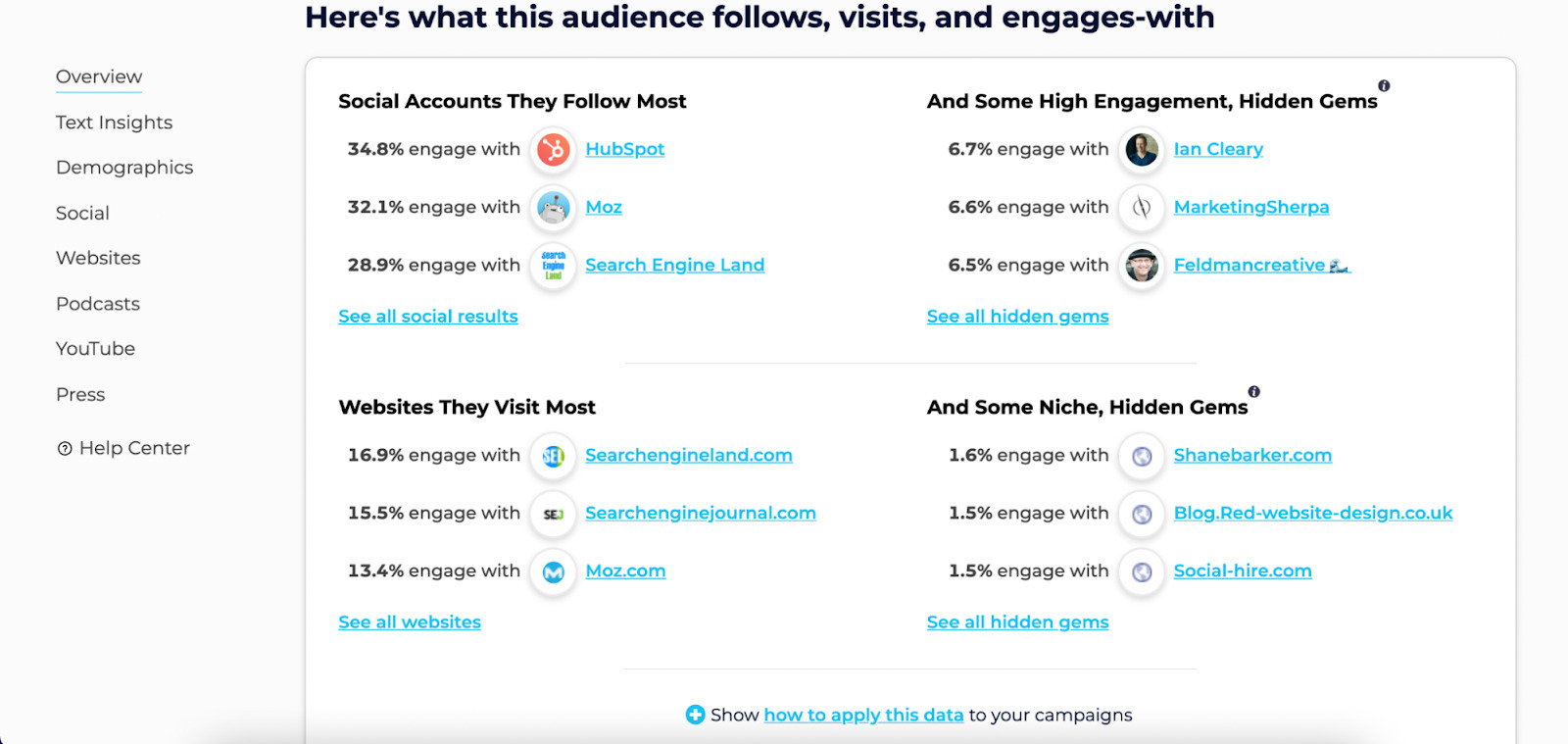
Furthermore, using multiple marketing channels allows you to distribute content more effectively. You can:
- Repurpose content into other formats and platforms.
- Build an audience to distribute content directly (for example, grow your email list).
- Promote the content via ads or sponsored newsletters.
- Syndicate articles to other websites.
Here’s an example. Our thoughts on using ChatGPT for SEO were used in a YouTube video, on our blog, and on social media. While there may be some overlap between these audiences, they are definitely not identical. So by using the multi-channel approach, we were able to get more eyes on our content.
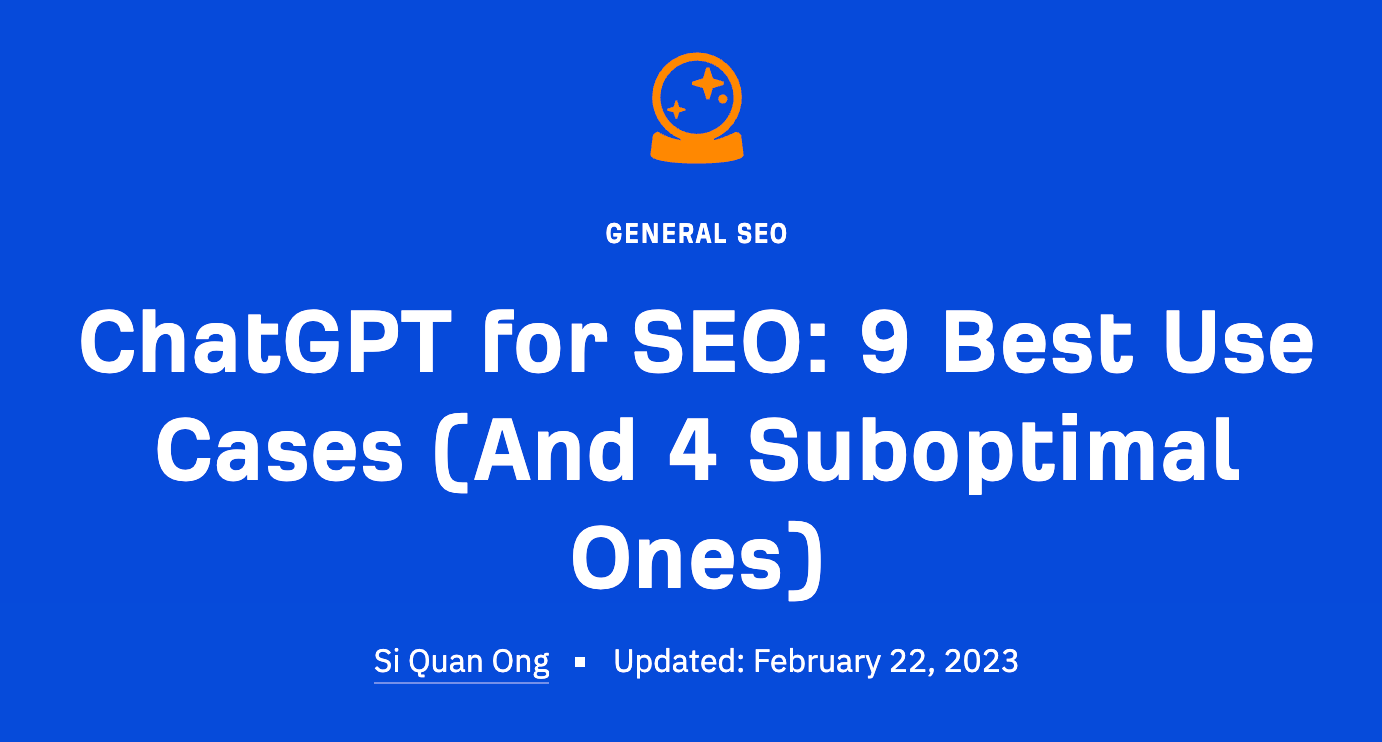
A growth loop is a system where new user input creates an output that drives product demand.
To illustrate, here’s how Notion used a product feature to activate and retain users (courtesy of Foundation).
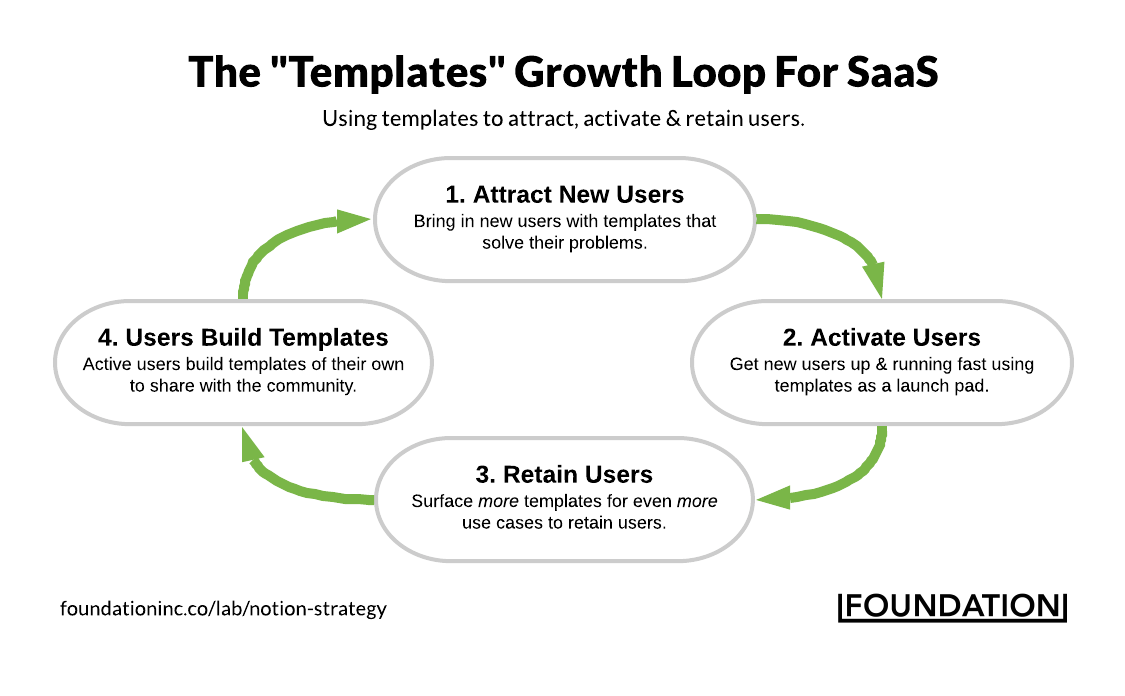
Growth loops are a stellar example of a sustainable marketing strategy because the whole model creates a loop. The more you grow, the more users you get, and so the more you grow.
Furthermore, this strategy gives your marketing budget more “power” since each dollar invested in acquiring a user is also invested in the users generated via the loop.
How it works
The simplest (but super effective) form of a growth loop is making your product outstanding. When your customers love the product and recommend it to others, you start growing on word of mouth—you acquire users you spent nothing to get.
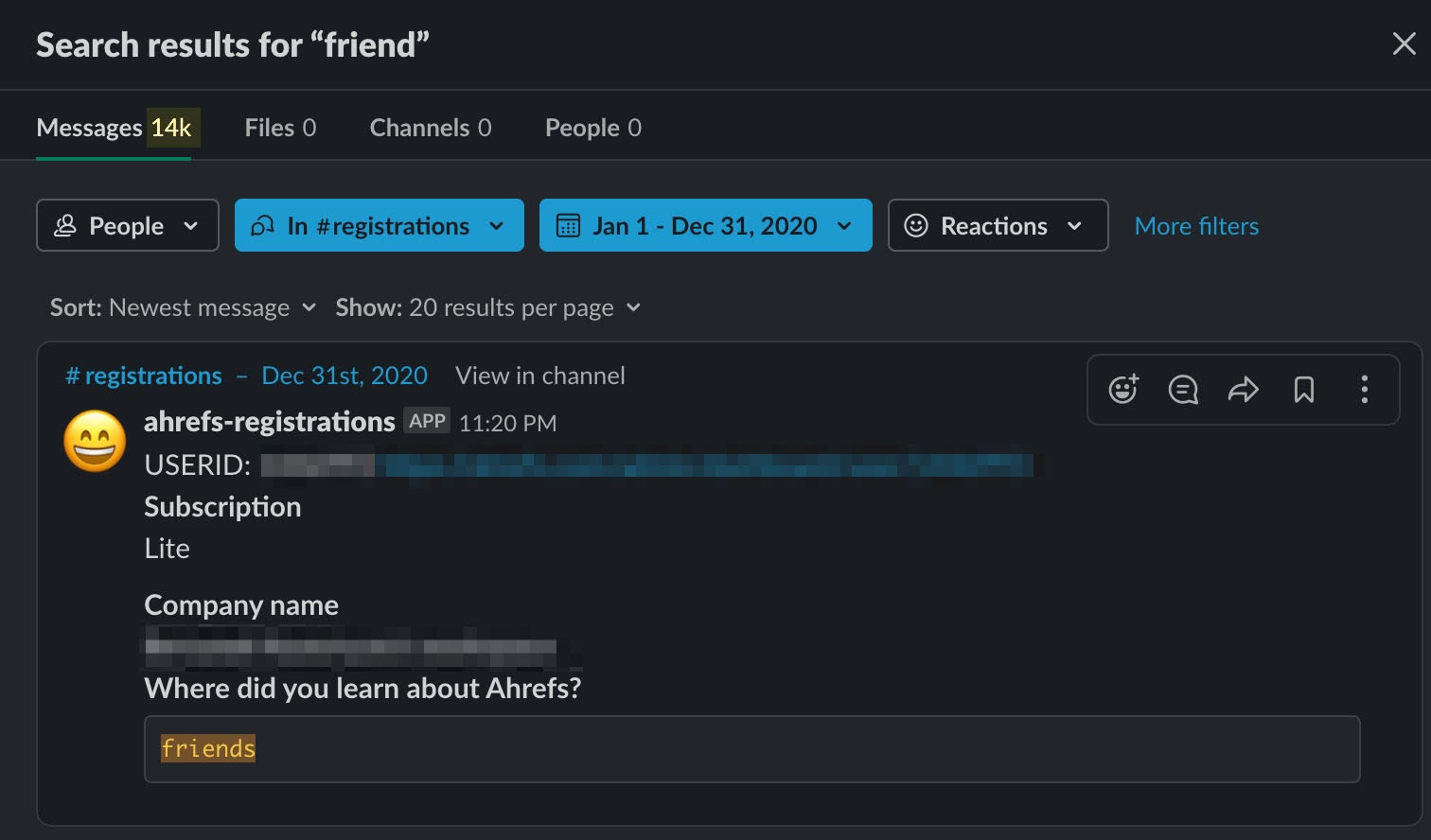
In some types of products, it’s possible to go beyond word of mouth and create a typical growth loop. It all depends on your product and your creativity. Here are a couple of levers you can pull:
- Make it easier for users to share their work publicly like Adobe with Behance
- Devise a referral program like Dropbox
- Create a marketplace for apps like Atlassian or WordPress
- Release an API like OpenAI
- Encourage user-generated content like G2
- Allow for free product usage after creating a free account like Figma or Loom
- Allow users to invite others to their workspaces like Slack or Miro
Revenue expansion is the additional revenue you get from your existing customers through upselling, cross-selling, and add-ons.
It’s a strategy that has proven to work for decades in multiple industries. For instance, this is why when you order a regular pizza, you’re offered to get a bigger one, get a drink with it, or add some extra ingredients.
And here’s an example from the SaaS world. When subscribing to HubSpot, you’re offered to upgrade by increasing the limit of contacts and also to purchase add-ons.
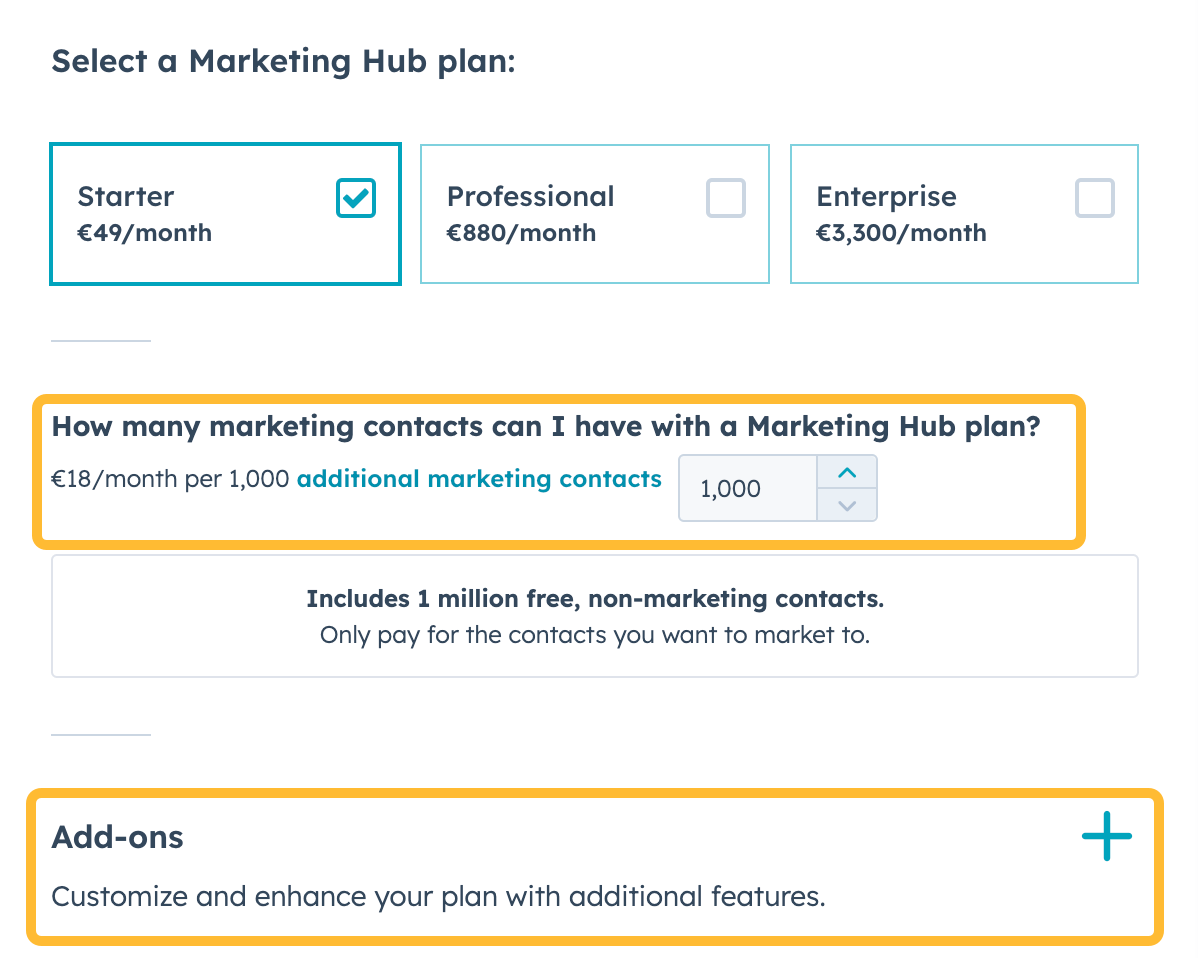
According to a correlation study published by ProfitWell, SaaS subscription-based companies should aim for 20% to 30% expansion revenue in their overall revenue in order to succeed.

You’ve probably heard that it’s better to retain a customer than to get a new one. That old business adage still holds true. According to this 2016 survey, SaaS companies spend an average of $1.16 to earn $1 on new annual contract value but only $0.27 on upsells and $0.20 on plan expansions.
How it works
If you offer additional value to your satisfied customers, there’s a good chance those customers will be happy to buy more from you. Here are some ideas for creating value for revenue expansion:
- Offer premium features on higher plans
- Offer a per-seat model to cater to both small and large companies
- Add a custom/enterprise tier for the most demanding customers
- Offer priority support
For example, when design tool UXPin developed a way to design with production-ready components, it decided to offer that as a premium version of the product with an almost 80% higher price tag than the UXPin Standard version.

But how to know when and if your customers are willing to expand? Here are some signals:
- Customers often reach their usage limit.
- Customers express interest in additional features or higher tiers.
- Your competitors offer a successful expansion system.
- You’ve got an awesome idea for a premium feature.
Growth marketing is the process of increasing a company’s revenue by applying an experiment-driven and integrated approach to all stages of attracting customers.
To understand this type of marketing better, let’s compare it to traditional marketing and growth hacking (the close variant I don’t recommend).

While the obvious solution for more sales is getting more visitors, this is not always the best one. If the product lacks competitive features and if there are obstacles on the path to purchase, money spent on getting more people through the door will always lead to low conversion and high churn. This is where growth marketing comes in.
A great example of growth-oriented thinking is LinkedIn’s Reconnect Flow. It’s a nickname for the early onboarding process where new users were asked questions about their personal experiences and offered connections to existing LinkedIn users based on that. This simple tactic engaged both new and old users.
Another interesting growth tactic LinkedIn used in the early days was encouraging users to import their email contacts (not a common thing back then). It was enough for 7% of new users to import their contacts to increase the overall number of invitations to 30%.
How it works
The idea behind growth marketing is based on the scientific method: propose hypotheses and validate them through experimentation. In marketing, it’s known as the growth hacking cycle.
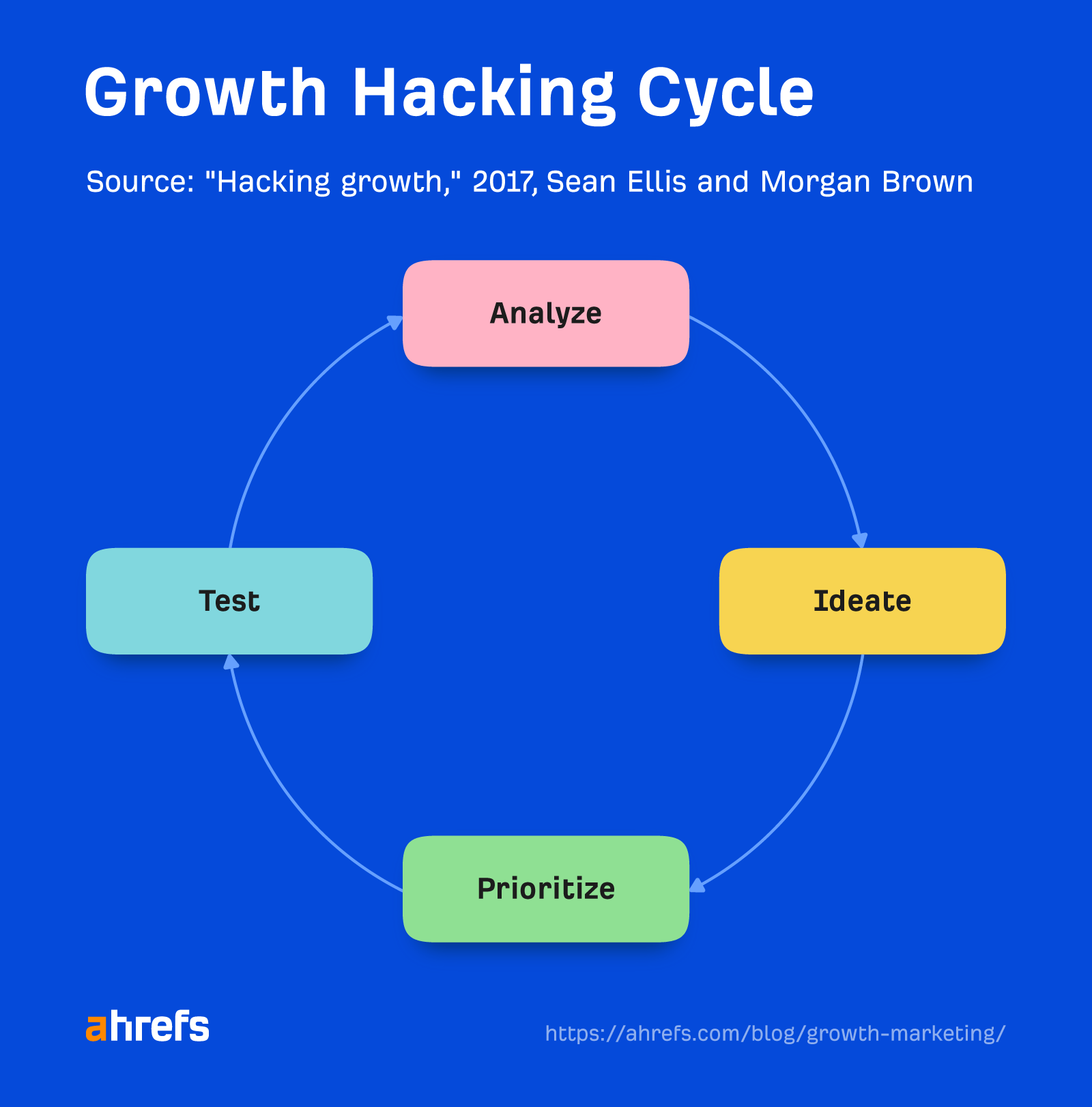
The whole cycle starts by gathering data on the buyer’s journey. Next is generating ideas on how to improve and then testing those ideas (for example through A/B testing).
It may seem like an obvious way to do marketing. But it’s not always that easy: Some tests may be hard to perform, and discipline is required. Also, it’s always faster (but not better) to go with your gut.
An important part of the growth mindset is the ability to analytically break down big problems into smaller pieces. This approach allows for setting more achievable goals.
For instance, a goal to increase sales is too vague because sales rely on many factors and not all of them are controllable. Instead, growth marketers may want to discover what “moves the needle.” Depending on the product, this may be encouraging the user to perform specific actions in the product or gearing pricing and communication toward a new audience.
Final thoughts
Sustainable growth doesn’t rely only on the strategies or tactics you choose. You need to give them time to work out the returns. You also need to experiment with them to see what works best for you.
There’s a great talk by Rand Fishkin on the concept of the flywheel in marketing; how the first push is the hardest, but it builds momentum that makes things easier in the long run. Sustainable growth strategies are just like that. As you build more value into your product and your brand, you gain momentum that acts as a multiplier for every new thing you do.
Got questions or comments? Ping me on Twitter or Mastodon.
SEO
How To Use ChatGPT For Keyword Research

Anyone not using ChatGPT for keyword research is missing a trick.
You can save time and understand an entire topic in seconds instead of hours.
In this article, I outline my most effective ChatGPT prompts for keyword research and teach you how I put them together so that you, too, can take, edit, and enhance them even further.
But before we jump into the prompts, I want to emphasize that you shouldn’t replace keyword research tools or disregard traditional keyword research methods.
ChatGPT can make mistakes. It can even create new keywords if you give it the right prompt. For example, I asked it to provide me with a unique keyword for the topic “SEO” that had never been searched before.
“Interstellar Internet SEO: Optimizing content for the theoretical concept of an interstellar internet, considering the challenges of space-time and interplanetary communication delays.”
Although I want to jump into my LinkedIn profile and update my title to “Interstellar Internet SEO Consultant,” unfortunately, no one has searched that (and they probably never will)!
You must not blindly rely on the data you get back from ChatGPT.
What you can rely on ChatGPT for is the topic ideation stage of keyword research and inspiration.
ChatGPT is a large language model trained with massive amounts of data to accurately predict what word will come next in a sentence. However, it does not know how to do keyword research yet.
Instead, think of ChatGPT as having an expert on any topic armed with the information if you ask it the right question.
In this guide, that is exactly what I aim to teach you how to do – the most essential prompts you need to know when performing topical keyword research.
Best ChatGPT Keyword Research Prompts
The following ChatGPT keyword research prompts can be used on any niche, even a topic to which you are brand new.
For this demonstration, let’s use the topic of “SEO” to demonstrate these prompts.
Generating Keyword Ideas Based On A Topic
What Are The {X} Most Popular Sub-topics Related To {Topic}?
The first prompt is to give you an idea of the niche.
As shown above, ChatGPT did a great job understanding and breaking down SEO into three pillars: on-page, off-page & technical.
The key to the following prompt is to take one of the topics ChatGPT has given and query the sub-topics.
What Are The {X} Most Popular Sub-topics Related To {Sub-topic}?
For this example, let’s query, “What are the most popular sub-topics related to keyword research?”
Having done keyword research for over 10 years, I would expect it to output information related to keyword research metrics, the types of keywords, and intent.
Let’s see.
 Screenshot from ChatGPT 4, April 2024
Screenshot from ChatGPT 4, April 2024Again, right on the money.
To get the keywords you want without having ChatGPT describe each answer, use the prompt “list without description.”
Here is an example of that.
List Without Description The Top {X} Most Popular Keywords For The Topic Of {X}
You can even branch these keywords out further into their long-tail.
Example prompt:
List Without Description The Top {X} Most Popular Long-tail Keywords For The Topic “{X}”
 Screenshot ChatGPT 4,April 2024
Screenshot ChatGPT 4,April 2024List Without Description The Top Semantically Related Keywords And Entities For The Topic {X}
You can even ask ChatGPT what any topic’s semantically related keywords and entities are!
 Screenshot ChatGPT 4, April 2024
Screenshot ChatGPT 4, April 2024Tip: The Onion Method Of Prompting ChatGPT
When you are happy with a series of prompts, add them all to one prompt. For example, so far in this article, we have asked ChatGPT the following:
- What are the four most popular sub-topics related to SEO?
- What are the four most popular sub-topics related to keyword research
- List without description the top five most popular keywords for “keyword intent”?
- List without description the top five most popular long-tail keywords for the topic “keyword intent types”?
- List without description the top semantically related keywords and entities for the topic “types of keyword intent in SEO.”
Combine all five into one prompt by telling ChatGPT to perform a series of steps. Example:
“Perform the following steps in a consecutive order Step 1, Step 2, Step 3, Step 4, and Step 5”
Example:
“Perform the following steps in a consecutive order Step 1, Step 2, Step 3, Step 4 and Step 5. Step 1 – Generate an answer for the 3 most popular sub-topics related to {Topic}?. Step 2 – Generate 3 of the most popular sub-topics related to each answer. Step 3 – Take those answers and list without description their top 3 most popular keywords. Step 4 – For the answers given of their most popular keywords, provide 3 long-tail keywords. Step 5 – for each long-tail keyword offered in the response, a list without descriptions 3 of their top semantically related keywords and entities.”
Generating Keyword Ideas Based On A Question
Taking the steps approach from above, we can get ChatGPT to help streamline getting keyword ideas based on a question. For example, let’s ask, “What is SEO?”
“Perform the following steps in a consecutive order Step 1, Step 2, Step 3, and Step 4. Step 1 Generate 10 questions about “{Question}”?. Step 2 – Generate 5 more questions about “{Question}” that do not repeat the above. Step 3 – Generate 5 more questions about “{Question}” that do not repeat the above. Step 4 – Based on the above Steps 1,2,3 suggest a final list of questions avoiding duplicates or semantically similar questions.”
 Screenshot ChatGPT 4, April 2024
Screenshot ChatGPT 4, April 2024Generating Keyword Ideas Using ChatGPT Based On The Alphabet Soup Method
One of my favorite methods, manually, without even using a keyword research tool, is to generate keyword research ideas from Google autocomplete, going from A to Z.
-
 Screenshot from Google autocomplete, April 2024
Screenshot from Google autocomplete, April 2024
You can also do this using ChatGPT.
Example prompt:
“give me popular keywords that includes the keyword “SEO”, and the next letter of the word starts with a”
 Screenshot from ChatGPT 4, April 2024
Screenshot from ChatGPT 4, April 2024Tip: Using the onion prompting method above, we can combine all this in one prompt.
“Give me five popular keywords that include “SEO” in the word, and the following letter starts with a. Once the answer has been done, move on to giving five more popular keywords that include “SEO” for each letter of the alphabet b to z.”
Generating Keyword Ideas Based On User Personas
When it comes to keyword research, understanding user personas is essential for understanding your target audience and keeping your keyword research focused and targeted. ChatGPT may help you get an initial understanding of customer personas.
Example prompt:
“For the topic of “{Topic}” list 10 keywords each for the different types of user personas”
 Screenshot from ChatGPT 4, April 2024
Screenshot from ChatGPT 4, April 2024You could even go a step further and ask for questions based on those topics that those specific user personas may be searching for:
 Screenshot ChatGPT 4, April 2024
Screenshot ChatGPT 4, April 2024As well as get the keywords to target based on those questions:
“For each question listed above for each persona, list the keywords, as well as the long-tail keywords to target, and put them in a table”
 Screenshot from ChatGPT 4, April 2024
Screenshot from ChatGPT 4, April 2024Generating Keyword Ideas Using ChatGPT Based On Searcher Intent And User Personas
Understanding the keywords your target persona may be searching is the first step to effective keyword research. The next step is to understand the search intent behind those keywords and which content format may work best.
For example, a business owner who is new to SEO or has just heard about it may be searching for “what is SEO.”
However, if they are further down the funnel and in the navigational stage, they may search for “top SEO firms.”
You can query ChatGPT to inspire you here based on any topic and your target user persona.
SEO Example:
“For the topic of “{Topic}” list 10 keywords each for the different types of searcher intent that a {Target Persona} would be searching for”
ChatGPT For Keyword Research Admin
Here is how you can best use ChatGPT for keyword research admin tasks.
Using ChatGPT As A Keyword Categorization Tool
One of the use cases for using ChatGPT is for keyword categorization.
In the past, I would have had to devise spreadsheet formulas to categorize keywords or even spend hours filtering and manually categorizing keywords.
ChatGPT can be a great companion for running a short version of this for you.
Let’s say you have done keyword research in a keyword research tool, have a list of keywords, and want to categorize them.
You could use the following prompt:
“Filter the below list of keywords into categories, target persona, searcher intent, search volume and add information to a six-column table: List of keywords – [LIST OF KEYWORDS], Keyword Search Volume [SEARCH VOLUMES] and Keyword Difficulties [KEYWORD DIFFICUTIES].”
-
 Screenshot from ChatGPT, April 2024
Screenshot from ChatGPT, April 2024
Tip: Add keyword metrics from the keyword research tools, as using the search volumes that a ChatGPT prompt may give you will be wildly inaccurate at best.
Using ChatGPT For Keyword Clustering
Another of ChatGPT’s use cases for keyword research is to help you cluster. Many keywords have the same intent, and by grouping related keywords, you may find that one piece of content can often target multiple keywords at once.
However, be careful not to rely only on LLM data for clustering. What ChatGPT may cluster as a similar keyword, the SERP or the user may not agree with. But it is a good starting point.
The big downside of using ChatGPT for keyword clustering is actually the amount of keyword data you can cluster based on the memory limits.
So, you may find a keyword clustering tool or script that is better for large keyword clustering tasks. But for small amounts of keywords, ChatGPT is actually quite good.
A great use small keyword clustering use case using ChatGPT is for grouping People Also Ask (PAA) questions.
Use the following prompt to group keywords based on their semantic relationships. For example:
“Organize the following keywords into groups based on their semantic relationships, and give a short name to each group: [LIST OF PAA], create a two-column table where each keyword sits on its own row.
-
 Screenshot from ChatGPT, April 2024
Screenshot from ChatGPT, April 2024
Using Chat GPT For Keyword Expansion By Patterns
One of my favorite methods of doing keyword research is pattern spotting.
Most seed keywords have a variable that can expand your target keywords.
Here are a few examples of patterns:
1. Question Patterns
(who, what, where, why, how, are, can, do, does, will)
“Generate [X] keywords for the topic “[Topic]” that contain any or all of the following “who, what, where, why, how, are, can, do, does, will”
 Screenshot ChatGPT 4, April 2024
Screenshot ChatGPT 4, April 20242. Comparison Patterns
Example:
“Generate 50 keywords for the topic “{Topic}” that contain any or all of the following “for, vs, alternative, best, top, review”
 Screenshot ChatGPT 4, April 2024
Screenshot ChatGPT 4, April 20243. Brand Patterns
Another one of my favorite modifiers is a keyword by brand.
We are probably all familiar with the most popular SEO brands; however, if you aren’t, you could ask your AI friend to do the heavy lifting.
Example prompt:
“For the top {Topic} brands what are the top “vs” keywords”
 Screenshot ChatGPT 4, April 2024
Screenshot ChatGPT 4, April 20244. Search Intent Patterns
One of the most common search intent patterns is “best.”
When someone is searching for a “best {topic}” keyword, they are generally searching for a comprehensive list or guide that highlights the top options, products, or services within that specific topic, along with their features, benefits, and potential drawbacks, to make an informed decision.
Example:
“For the topic of “[Topic]” what are the 20 top keywords that include “best”
 Screenshot ChatGPT 4, April 2024
Screenshot ChatGPT 4, April 2024Again, this guide to keyword research using ChatGPT has emphasized the ease of generating keyword research ideas by utilizing ChatGPT throughout the process.
Keyword Research Using ChatGPT Vs. Keyword Research Tools
Free Vs. Paid Keyword Research Tools
Like keyword research tools, ChatGPT has free and paid options.
However, one of the most significant drawbacks of using ChatGPT for keyword research alone is the absence of SEO metrics to help you make smarter decisions.
To improve accuracy, you could take the results it gives you and verify them with your classic keyword research tool – or vice versa, as shown above, uploading accurate data into the tool and then prompting.
However, you must consider how long it takes to type and fine-tune your prompt to get your desired data versus using the filters within popular keyword research tools.
For example, if we use a popular keyword research tool using filters, you could have all of the “best” queries with all of their SEO metrics:
-
 Screenshot from Ahrefs Keyword Explorer, March 2024
Screenshot from Ahrefs Keyword Explorer, March 2024
And unlike ChatGPT, generally, there is no token limit; you can extract several hundred, if not thousands, of keywords at a time.
As I have mentioned multiple times throughout this piece, you cannot blindly trust the data or SEO metrics it may attempt to provide you with.
The key is to validate the keyword research with a keyword research tool.
ChatGPT For International SEO Keyword Research
ChatGPT can be a terrific multilingual keyword research assistant.
For example, if you wanted to research keywords in a foreign language such as French. You could ask ChatGPT to translate your English keywords;
 Screenshot ChatGPT 4, Apil 2024
Screenshot ChatGPT 4, Apil 2024- The key is to take the data above and paste it into a popular keyword research tool to verify.
- As you can see below, many of the keyword translations for the English keywords do not have any search volume for direct translations in French.
 Screenshot from Ahrefs Keyword Explorer, April 2024
Screenshot from Ahrefs Keyword Explorer, April 2024But don’t worry, there is a workaround: If you have access to a competitor keyword research tool, you can see what webpage is ranking for that query – and then identify the top keyword for that page based on the ChatGPT translated keywords that do have search volume.
-
-
 Screenshot from Ahrefs Keyword Explorer, April 2024
Screenshot from Ahrefs Keyword Explorer, April 2024
Or, if you don’t have access to a paid keyword research tool, you could always take the top-performing result, extract the page copy, and then ask ChatGPT what the primary keyword for the page is.
Key Takeaway
-
ChatGPT can be an expert on any topic and an invaluable keyword research tool. However, it is another tool to add to your toolbox when doing keyword research; it does not replace traditional keyword research tools.
As shown throughout this tutorial, from making up keywords at the beginning to inaccuracies around data and translations, ChatGPT can make mistakes when used for keyword research.
You cannot blindly trust the data you get back from ChatGPT.
However, it can offer a shortcut to understanding any topic for which you need to do keyword research and, as a result, save you countless hours.
But the key is how you prompt.
The prompts I shared with you above will help you understand a topic in minutes instead of hours and allow you to better seed keywords using keyword research tools.
It can even replace mundane keyword clustering tasks that you used to do with formulas in spreadsheets or generate ideas based on keywords you give it.
Paired with traditional keyword research tools, ChatGPT for keyword research can be a powerful tool in your arsenal.
More resources:
Featured Image: Tatiana Shepeleva/Shutterstock
SEO
OpenAI Expected to Integrate Real-Time Data In ChatGPT

Sam Altman, CEO of OpenAI, dispelled rumors that a new search engine would be announced on Monday, May 13. Recent deals have raised the expectation that OpenAI will announce the integration of real-time content from English, Spanish, and French publications into ChatGPT, complete with links to the original sources.
OpenAI Search Is Not Happening
Many competing search engines have tried and failed to challenge Google as the leading search engine. A new wave of hybrid generative AI search engines is currently trying to knock Google from the top spot with arguably very little success.
Sam Altman is on record saying that creating a search engine to compete against Google is not a viable approach. He suggested that technological disruption was the way to replace Google by changing the search paradigm altogether. The speculation that Altman is going to announce a me-too search engine on Monday never made sense given his recent history of dismissing the concept as a non-starter.
So perhaps it’s not a surprise that he recently ended the speculation by explicitly saying that he will not be announcing a search engine on Monday.
He tweeted:
“not gpt-5, not a search engine, but we’ve been hard at work on some new stuff we think people will love! feels like magic to me.”
“New Stuff” May Be Iterative Improvement
It’s quite likely that what’s going to be announced is iterative which means it improves ChatGPT but not replaces it. This fits into how Altman recently expressed his approach with ChatGPT.
He remarked:
“And it does kind of suck to ship a product that you’re embarrassed about, but it’s much better than the alternative. And in this case in particular, where I think we really owe it to society to deploy iteratively.
There could totally be things in the future that would change where we think iterative deployment isn’t such a good strategy, but it does feel like the current best approach that we have and I think we’ve gained a lot from from doing this and… hopefully the larger world has gained something too.”
Improving ChatGPT iteratively is Sam Altman’s preference and recent clues point to what those changes may be.
Recent Deals Contain Clues
OpenAI has been making deals with news media and User Generated Content publishers since December 2023. Mainstream media has reported these deals as being about licensing content for training large language models. But they overlooked a a key detail that we reported on last month which is that these deals give OpenAI access to real-time information that they stated will be used to give attribution to that real-time data in the form of links.
That means that ChatGPT users will gain the ability to access real-time news and to use that information creatively within ChatGPT.
Dotdash Meredith Deal
Dotdash Meredith (DDM) is the publisher of big brand publications such as Better Homes & Gardens, FOOD & WINE, InStyle, Investopedia, and People magazine. The deal that was announced goes way beyond using the content as training data. The deal is explicitly about surfacing the Dotdash Meredith content itself in ChatGPT.
The announcement stated:
“As part of the agreement, OpenAI will display content and links attributed to DDM in relevant ChatGPT responses. …This deal is a testament to the great work OpenAI is doing on both fronts to partner with creators and publishers and ensure a healthy Internet for the future.
Over 200 million Americans each month trust our content to help them make decisions, solve problems, find inspiration, and live fuller lives. This partnership delivers the best, most relevant content right to the heart of ChatGPT.”
A statement from OpenAI gives credibility to the speculation that OpenAI intends to directly show licensed third-party content as part of ChatGPT answers.
OpenAI explained:
“We’re thrilled to partner with Dotdash Meredith to bring its trusted brands to ChatGPT and to explore new approaches in advancing the publishing and marketing industries.”
Something that DDM also gets out of this deal is that OpenAI will enhance DDM’s in-house ad targeting in order show more tightly focused contextual advertising.
Le Monde And Prisa Media Deals
In March 2024 OpenAI announced a deal with two global media companies, Le Monde and Prisa Media. Le Monde is a French news publication and Prisa Media is a Spanish language multimedia company. The interesting aspects of these two deals is that it gives OpenAI access to real-time data in French and Spanish.
Prisa Media is a global Spanish language media company based in Madrid, Spain that is comprised of magazines, newspapers, podcasts, radio stations, and television networks. It’s reach extends from Spain to America. American media companies include publications in the United States, Argentina, Bolivia, Chile, Colombia, Costa Rica, Ecuador, Mexico, and Panama. That is a massive amount of real-time information in addition to a massive audience of millions.
OpenAI explicitly announced that the purpose of this deal was to bring this content directly to ChatGPT users.
The announcement explained:
“We are continually making improvements to ChatGPT and are supporting the essential role of the news industry in delivering real-time, authoritative information to users. …Our partnerships will enable ChatGPT users to engage with Le Monde and Prisa Media’s high-quality content on recent events in ChatGPT, and their content will also contribute to the training of our models.”
That deal is not just about training data. It’s about bringing current events data to ChatGPT users.
The announcement elaborated in more detail:
“…our goal is to enable ChatGPT users around the world to connect with the news in new ways that are interactive and insightful.”
As noted in our April 30th article that revealed that OpenAI will show links in ChatGPT, OpenAI intends to show third party content with links to that content.
OpenAI commented on the purpose of the Le Monde and Prisa Media partnership:
“Over the coming months, ChatGPT users will be able to interact with relevant news content from these publishers through select summaries with attribution and enhanced links to the original articles, giving users the ability to access additional information or related articles from their news sites.”
There are additional deals with other groups like The Financial Times which also stress that this deal will result in a new ChatGPT feature that will allow users to interact with real-time news and current events .
OpenAI’s Monday May 13 Announcement
There are many clues that the announcement on Monday will be that ChatGPT users will gain the ability to interact with content about current events. This fits into the terms of recent deals with news media organizations. There may be other features announced as well but this part is something that there are many clues pointing to.
Watch Altman’s interview at Stanford University
Featured Image by Shutterstock/photosince
SEO
Google’s Strategies For Dealing With Content Decay

In the latest episode of the Search Off The Record podcast, Google Search Relations team members John Mueller and Lizzi Sassman did a deep dive into dealing with “content decay” on websites.
Outdated content is a natural issue all sites face over time, and Google has outlined strategies beyond just deleting old pages.
While removing stale content is sometimes necessary, Google recommends taking an intentional, format-specific approach to tackling content decay.
Archiving vs. Transitional Guides
Google advises against immediately removing content that becomes obsolete, like materials referencing discontinued products or services.
Removing content too soon could confuse readers and lead to a poor experience, Sassman explains:
“So, if I’m trying to find out like what happened, I almost need that first thing to know. Like, “What happened to you?” And, otherwise, it feels almost like an error. Like, “Did I click a wrong link or they redirect to the wrong thing?””
Sassman says you can avoid confusion by providing transitional “explainer” pages during deprecation periods.
A temporary transition guide informs readers of the outdated content while steering them toward updated resources.
Sassman continues:
“That could be like an intermediary step where maybe you don’t do that forever, but you do it during the transition period where, for like six months, you have them go funnel them to the explanation, and then after that, all right, call it a day. Like enough people know about it. Enough time has passed. We can just redirect right to the thing and people aren’t as confused anymore.”
When To Update Vs. When To Write New Content
For reference guides and content that provide authoritative overviews, Google suggests updating information to maintain accuracy and relevance.
However, for archival purposes, major updates may warrant creating a new piece instead of editing the original.
Sassman explains:
“I still want to retain the original piece of content as it was, in case we need to look back or refer to it, and to change it or rehabilitate it into a new thing would almost be worth republishing as a new blog post if we had that much additional things to say about it.”
Remove Potentially Harmful Content
Google recommends removing pages in cases where the outdated information is potentially harmful.
Sassman says she arrived at this conclusion when deciding what to do with a guide involving obsolete structured data:
“I think something that we deleted recently was the “How to Structure Data” documentation page, which I thought we should just get rid of it… it almost felt like that’s going to be more confusing to leave it up for a period of time.
And actually it would be negative if people are still adding markup, thinking they’re going to get something. So what we ended up doing was just delete the page and redirect to the changelog entry so that, if people clicked “How To Structure Data” still, if there was a link somewhere, they could still find out what happened to that feature.”
Internal Auditing Processes
To keep your content current, Google advises implementing a system for auditing aging content and flagging it for review.
Sassman says she sets automated alerts for pages that haven’t been checked in set periods:
“Oh, so we have a little robot to come and remind us, “Hey, you should come investigate this documentation page. It’s been x amount of time. Please come and look at it again to make sure that all of your links are still up to date, that it’s still fresh.””
Context Is Key
Google’s tips for dealing with content decay center around understanding the context of outdated materials.
You want to prevent visitors from stumbling across obsolete pages without clarity.
Additional Google-recommended tactics include:
- Prominent banners or notices clarifying a page’s dated nature
- Listing original publish dates
- Providing inline annotations explaining how older references or screenshots may be obsolete
How This Can Help You
Following Google’s recommendations for tackling content decay can benefit you in several ways:
- Improved user experience: By providing clear explanations, transition guides, and redirects, you can ensure that visitors don’t encounter confusing or broken pages.
- Maintained trust and credibility: Removing potentially harmful or inaccurate content and keeping your information up-to-date demonstrates your commitment to providing reliable and trustworthy resources.
- Better SEO: Regularly auditing and updating your pages can benefit your website’s search rankings and visibility.
- Archival purposes: By creating new content instead of editing older pieces, you can maintain a historical record of your website’s evolution.
- Streamlined content management: Implementing internal auditing processes makes it easier to identify and address outdated or problematic pages.
By proactively tackling content decay, you can keep your website a valuable resource, improve SEO, and maintain an organized content library.
Listen to the full episode of Google’s podcast below:
Featured Image: Stokkete/Shutterstock
-

 PPC5 days ago
PPC5 days agoHow the TikTok Algorithm Works in 2024 (+9 Ways to Go Viral)
-

 MARKETING7 days ago
MARKETING7 days agoA Recap of Everything Marketers & Advertisers Need to Know
-

 SEO4 days ago
SEO4 days agoHow to Use Keywords for SEO: The Complete Beginner’s Guide
-

 SEO6 days ago
SEO6 days agoBlog Post Checklist: Check All Prior to Hitting “Publish”
-

 MARKETING5 days ago
MARKETING5 days agoHow To Protect Your People and Brand
-

 SEARCHENGINES6 days ago
SEARCHENGINES6 days agoGoogle Started Enforcing The Site Reputation Abuse Policy
-

 PPC6 days ago
PPC6 days agoHow to Craft Compelling Google Ads for eCommerce
-

 SEARCHENGINES7 days ago
SEARCHENGINES7 days agoGoogle Says Again, Sites Hit By The Old Helpful Content Update Can Recover













